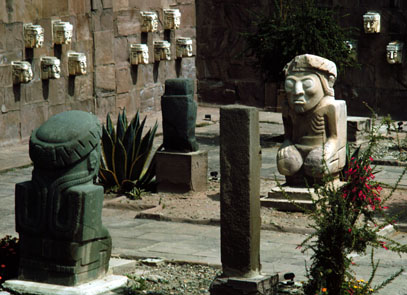
Tiwanaku Problems

 The remains of the city known as Tiwanaku, in Bolivia, is a well studied site and the archaeological evidence informs us that it was first inhabited circa 1,500 bce. Radiocarbon (C14) dates and pottery analysis from the site prove that although human habitation began at around this date, the city did not reach its peak until between AD100 - 900 and that it was used until about AD1000. The remains of the city known as Tiwanaku, in Bolivia, is a well studied site and the archaeological evidence informs us that it was first inhabited circa 1,500 bce. Radiocarbon (C14) dates and pottery analysis from the site prove that although human habitation began at around this date, the city did not reach its peak until between AD100 - 900 and that it was used until about AD1000.
A ritual city, Tiwanaku had a population of around 40,000 people with perhaps as many as 500,000 in the surrounding area. Tiwanaku is a wonderful example of a site in continuous use for a remarkable period of time. Hancock does not agree with the archaeology, he prefers to re-hash and alter the ideas of Arthur Posansky, who studied the site from about 1900 to the 1940s. Hancock has decided that the site fits his 10,500 bce date for his LC arriving in Egypt, in other words, Tiwanaku and it's contents are the product of his LC. Of course Hancock neglects to mention that his own dating and Posansky's dating are quite different. Hancock once again decides to overlook the conflicting evidence although he agrees with Posansky about the manner of the alignments etc. This is more than just selective representation as it grossly misleads the reader. You might well ask, does Hancock consult the archaeological findings before making any statements regarding the age of the site? In fact he totally ignores them, and one assumes that this is because it doesn't agree with his idea. Ignoring the findings of the site archaeologists, Hancock bypasses them and relies on the 57 year-old ideas of Posansky, who was neither an archaeologist, nor a geologist. Posnanskys lack of formal training does not prevent him from claiming that certain stones at Tiwanaku align with the solstices etc. None of the stones at Tiwanaku can be said to align with any stars or solar events, simply because the Spanish smashed the idolatrous site when they found it and it was used as a quarry by the locals for centuries. In Tiwanaku none of the stones are in their original positions, so star alignments are right out of the question. Hancock admits this in his BBC interview when he says: "I think the astronomical indications on the site are intriguing but not conclusive". So the star alignments are completely worthless at this site. Again and Again Hancock uses suggestion and innuendo to woo his audience. Another point that Hancock does not disclose is the dating by Posnasky to 15,000 BCE as opposed to Hancock's favoured 10,500 BCE. A mere 4,500 years difference, but since they are both utterly wrong does it matter? Well yes, Hancock cites Posnansky only when it suits him to do so, and this tells us as much as we need to know of his understanding of the scientific method. Given the unreliability of the astro-archaeological alignments, on what basis does Hancock agree with Posnansky? Leaving aside the hundreds of archaeological studies, the logical answer, or rather the illogical answer is this: "I think, above all else for me personally, its as much intuition as anything else-the site feels wrong for the date range that is ascribed to it by orthodox archaeologists. It just feels older, It's very difficult to prove anything like this, and I'm not trying to prove it." You might well ask, if he is not trying to prove it, what on earth is he saying? Furthermore, Hancock claims that we can determine the age of a site on the basis of his feelings alone. We can ignore the established and well-documented archaeological evidence so long as Hancock claims the date attributed to the site feels older. If Graham Hancock can produce good evidence for Tiwanku being something the archaeologists say it is not, then of course, we will be happy to reconsider the whole rational of the Site. What seems certain to me is this, Ancient peoples were more spiritual than we are, certainly , you cannot look at a site without realising this, and an understanding of the religion of the people is necessary before any Judgements of the monuments should be made, Graham has reminded us that we must not dehumanise Ancient cultures, but attempt to understand them in an holistic manner.  Discuss This Article: The Message Board |
